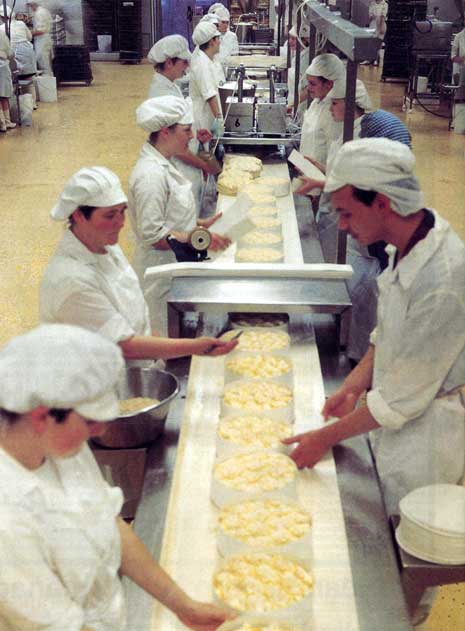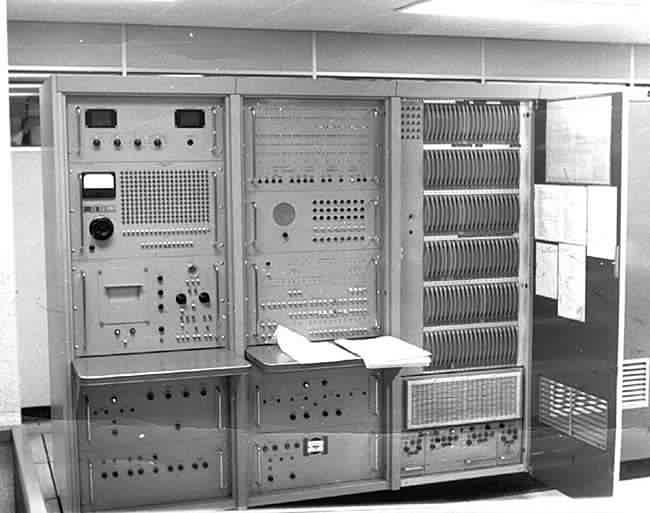
When top management at Lyons heard about the development of the "electronic brains" being used in the war, they decided that they needed something like that to make further progress in their business.(Leo Computer Society-6/11/03) In 1947 O.W. Standingford & T.R. Thompson, Assistant Comptroller and Chief Assistant Comptroller at Lyons visited the U.S. to find out if computers, which so far had only been used for mathematical calculations, were capable of being used in commercial offices. While in the U.S., Standingford & Thompson visited IBM and Electronic Control Company. They also got to see the ENIAC Computer, and the Harvard Mark I, II, and III computers. Another interesting visit was to the Prudential Insurance Company where they were told of a project to build an electronic machine to carry out the billing of millions of policy holders and automatically write insurance contracts.
Standingford & Thompson were also encouraged to visit Cambridge University, where the EDSAC Computer was in the developmental stages. Everyone they spoke with encouraged them in their project. In their report to the board of directors at the Lyons Company, various options were given, but the board voted unanimously to build their own business computers, this was May of 1949.
There were many talented young people who were involved in the building of the LEO Computers. Some stayed with LEO Computers until the very end and others moved on to high profile careers. What distinguished these early LEO consultants was their ability to take on all aspects of the job. Unlike in other companies, there were no specialists, everyone was developing and inventing on a daily basis. Late night sessions in the office were routine, and were rewarded by late night meals in the Executive Dining Suite, which they were barred from during normal working hours.
The LEO I was completed in 1951 and Princess Elizabeth was shown a test run in February. The first office job that the LEO Computer performed was run in November of 1951. The LEO Computer was the first computer system in the world to run a live office application to a regular time sensitive schedule. The first job run on the LEO I was to value all of the output to and from the dispatch center, giving credit to individual bakeries and charges to each of the channels of sale. The computer was required to calculate the "stock balance" for each item, comparing what had reached the dispatch with what had been issued and what was left over. The valuations were made at standard prices; standards were the clock by which the whole company ticked (Caminer-1998). Though this was a small job it opened the door for larger and more exciting jobs, such as: payroll, sales invoicing, stock control, and replenishment.

The LEO I Computer, at the time of the first job, occupied a room measuring 5000 square feet and had been put together on site. It was an electronic, stored program system able to accomodate 2048 instructions or 17 binary-bit numbers in a mercury delay-line accoustic store. The computer was controlled from a console with two video display tubes, showing binary images of the store contents. A loudspeaker provided a sound representation of the instructions being carried out.
On February 12, 1954 the LEO I Computer performed another first, the Lyon's payroll produced paychecks direct from the computer for 1670 staff of the bakeries without ever having to use the backup system. The LEO I was also featured on TV the day of the historic run of a payroll job.
Over the years a family of LEO computers evolved from the original design. A design for the LEO II was produced by Dr. John Pinkerton in May of 1954. This new design speeded up the computer by reducing the mercury delay line storage tubes to a quarter of their original size and featuring faster registers in the arithmetic unit and increasing word size. It also made provisions for the connection of magnetic tape and magnetic drums anticipating the time when this equipment would become available. Within a week of the design being submitted the Lyons board gave approval to go ahead with two of the new systems. The board of directors met on June 30, 1954 and decided to form a company, LEO Computers, LTD. The share capital was only $300.

In October of 1954, forty-two of Lyon's teashops were involved in a live test run of LEO II. By the end of 1955 the programming department was being run with experienced staff, and the LEO II was nearing completion. In May of 1957 the LEO II was fully operational and LEO Computers, LTD were already receiving orders for the machines: WD & HO Willis was the first to sign up for a system to handle invoicing and distribution of products, Stewarts & Lloyds, a family run steel firm, ordered a system for payroll, and The Ford Motor Company's parts depot at Aveley put in an order for a system as well. This order from Ford was viewed as particularly significant because any capital expenditures had to have approval from Detroit.
Most companies, partly because of the bulk of the LEO machines, paid for time on the Lyons machines on an as needed basis. Early users of this service were: EverReady, Kodak, and Tate & Lyle. The most used application was payroll. Other frequently used applications included: the preparation of the Government's Tax Tables, and the calculation of station to station distances for the British Railways Network.
In 1961 the LEO III was completed, it was one of the very first transistor machines, featuring microprogramming and multiprogramming, and a high level language, CLEO. They were a full three years ahead of the IBM 360 series. The LEO III was well received and the orders came quickly, ten systems were marked for delivery at the end of 1962 and through 1963-almost as many systems as had been installed in the lifetime of LEO II.

In February of 1963, a merger with the computer business of English Electric formed a new company called English Electric LEO Computers. The LEO staff, was stunned by this news, there had been no discussion with the LEO directors prior to this agreement. Before long conflicts started to errupt between the English Electric people, who believed that computers were equipment and sold by salesmen; and LEO people who felt that computers were part of a mission to bring efficiency to the office and the LEO consultant retained responsibility for the application well after the ink was dry on the contract (Leo Computer Society-6/11/03).
The merger was followed by many years in which the sale and installation of LEO computers took off. The introduction of LEO 326, a faster version of the LEO III, was able to run individual programs at five times the speed and run more programs concurrently. This new version helped to fuel the massive take-off of the LEO computers.
In April of 1964 the British Post Office in London and Lytham St. Anne's ordered five LEO 326's, the largest order ever placed with any computer vendor up to this time in the U.K. The LEO 326 was used successfully for many years, in fact, the post office used this system until March of 1981.
In October of 1981 English Electric purchased the remaining 50% of the Lyons' share of the business. The company merged many times after buying out the Lyons, the final merger was in 1968 with International Computers & Tabulators (ICT) to form International Computers Limited (ICL).
REFERENCES
- Caminer, David; Aris, John; Hermon, Peter; Land, Frank, 1998, LEO: The Incredible Story of the World's First Business Computer
- Http://www.kzwp.com/lyons/leo.htm
- Http://www.leo-computers.org.uk/pageone.htm